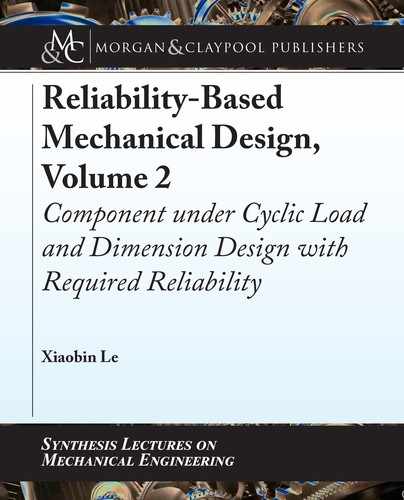Book Description
A component will not be reliable unless it is designed with required reliability.
Reliability-Based Mechanical Design uses the reliability to link all design parameters of a component together to form a limit state function for mechanical design. This design methodology uses the reliability to replace the factor of safety as a measure of the safe status of a component. The goal of this methodology is to design a mechanical component with required reliability and at the same time, quantitatively indicates the failure percentage of the component. Reliability-Based Mechanical Design consists of two separate books: Volume 1: Component under Static Load, and Volume 2: Component under Cyclic Load and Dimension Design with Required Reliability.
This book is Reliability-Based Mechanical Design, Volume 2: Component under Cyclic Load and Dimension Design with Required Reliability. It begins with a systematic description of a cyclic load. Then, the books use two probabilistic fatigue theories to establish the limit state function of a component under cyclic load, and further to present how to calculate the reliability of a component under a cyclic loading spectrum. Finally, the book presents how to conduct dimension design of typical components such as bar, pin, shaft, beam under static load, or cyclic loading spectrum with required reliability.
Now, the designed component will be reliable because it has been designed with the required reliability. The book presents many examples for each topic and provides a wide selection of exercise problems at the end of each chapter. This book is written as a textbook for senior mechanical engineering students after they study the course Design of Machine Elements or a similar course. This book is also a good reference for design engineers and presents design methods in such sufficient detail that those methods are readily used in the design.
Table of Contents
- Preface
- Introduction and Cyclic Loading Spectrum
- Reliability of a Component under Cyclic Load
- Introduction
- Fatigue Damage Mechanism
- Fatigue Test, S-N Curve, and Material Endurance Limit
- The Marin Modification Factors
- The Effect of Mean Stress
- The Fatigue Stress Concentration Factor
- Reliability of a Component with an Infinite Life (1/2)
- Reliability of a Component with an Infinite Life (2/2)
- Reliability of a Component by the P-S-N Curves Approach
- The Material P-S-N Curves
- The Component P-S-N Curves
- Reliability of a Component under Model #1 Cyclic Loading Spectrum (1/2)
- Reliability of a Component under Model #1 Cyclic Loading Spectrum (2/2)
- Reliability of a Component under Model #2 Cyclic Loading Spectrum
- Reliability of a Component under Model #3 Cyclic Loading Spectrum
- Reliability of a Component under Model #4 Cyclic Loading Spectrum
- Reliability of a Component under Model #5 Cyclic Loading Spectrum (1/2)
- Reliability of a Component under Model #5 Cyclic Loading Spectrum (2/2)
- Reliability of a Component under Model #6 Cyclic Loading Spectrum
- The Reliability of a Component with P-S-N Curves by the Monte Carlo Method
- The Probabilistic Fatigue Damage Theory (the K-D Model)
- Introduction
- The Material Fatigue Strength Index K_0
- The Component Fatigue Strength Index K
- The Component Fatigue Damage Index D
- The Probabilistic Fatigue Damage Theory (the K-D Model)
- Reliability of a Component under Cyclic Axial Loading
- Reliability of a Component under Cyclic Direct Shearing Loading
- Reliability of a Shaft under Cyclic Torsion Loading
- Reliability of a Beam under Cyclic Bending Loading
- Reliability of a Component under Cyclic Combined Loading
- Reliability of a Component with the K-D Model by the Monte Carlo Method
- The Comparison of Results by the K-D Model with the Results by the P-S-N Curves (1/2)
- The Comparison of Results by the K-D Model with the Results by the P-S-N Curves (2/2)
- Summary
- References
- Exercises (1/2)
- Exercises (2/2)
- The Dimension of a Component with Required Reliability
- Introduction
- Dimension Design with Required Reliability
- Limit State Function and Preliminary Design
- Dimension Design by the FOSM Method (1/2)
- Dimension Design by the FOSM Method (2/2)
- Dimension Design by the Modified H-L Method (1/2)
- Dimension Design by the Modified H-L Method (2/2)
- Dimension Design by the Modified R-F Method (1/2)
- Dimension Design by the Modified R-F Method (2/2)
- Dimension Design by the Modified Monte Carlo Method (1/2)
- Dimension Design by the Modified Monte Carlo Method (2/2)
- Dimension of a Component with Required Reliability under Static Loading
- Dimension of a Component with Required Reliability under Cyclic Loading Spectrum
- Introduction
- Component with an Infinite Fatigue Life
- Rod under Cyclic Axial Loading Spectrum
- Pin under Cyclic Direct Shearing Loading Spectrum
- Shaft under Cyclic Torsion Loading Spectrum
- Beam under Cyclic Bending Loading Spectrum (1/2)
- Beam under Cyclic Bending Loading Spectrum (2/2)
- Component under Cyclic Combined Loading Spectrum
- Summary
- References
- Exercises
- Computational Methods for the Reliability of a Component
- Samples of MATLAB® Programs
- Author's Biography
- Blank Page (1/4)
- Blank Page (2/4)
- Blank Page (3/4)
- Blank Page (4/4)
